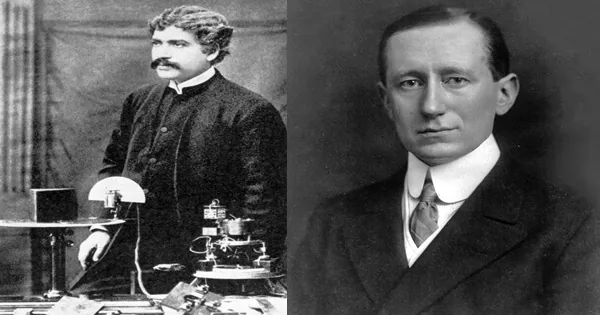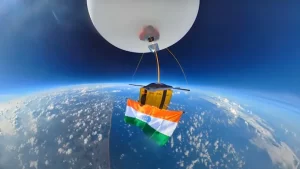A pioneer in radio technology research, showcasing wireless communication through radio waves nearly two years prior to Italian physicist Guglielmo Marconi, often attributed with the development of the first functional radio communication system in 1897.
A biologist, botanist, physicist, author and an inventor.
Significantly influencing the course of experimental science in the Indian subcontinent.
Being acknowledged as a pioneer and often revered as the father of Bengali science fiction, he also earned credit for inventing the crescograph—a device devised to measure plant growth.
It’s worth noting that a lunar crater was named in his honor.
Additionally, he founded the Bose Institute, an esteemed research establishment in India, established in 1917 as the first interdisciplinary research center in Asia.
He served as the Director of the Bose Institute from its inception until his passing.
Can you believe we are talking about 1 person and not 7 here?
Jagdish Chandra Bose, a multifaceted individual with numerous notable discoveries to his name, emphasized the significance of innovation over the identity of the innovator.
Always in struggle for the uplift of the people, yet with so little success, such frequent failures, that to most he seemed a failure. All this too gave me a lower and lower idea of all worldly success – how small its so-called victories are! – and higher and higher idea of conflict and defeat; and of true success born of defeat. In such ways I have come to feel one with the highest spirit of my race; with every fibre thrilling with the emotion of the past. That is its noblest teaching – that the only real and spiritual advantage is to fight fair, never to take crooked ways, but keep to the straight path, whatever be in the way.
~JC Bose
Invention of Radio Technology Research:
Bose’s fascination with radio technology was sparked by British physicist Oliver Lodge’s 1894 demonstrations on the transmission and detection of radio waves. In November 1894, Bose initiated his own exploration in this emerging field, setting up his equipment in a modest 20-square-foot room at Presidency College. He aimed to investigate the light-like properties of radio waves, a challenge given the long wavelengths. Bose successfully reduced the waves to the millimeter level, falling within the microwave range of approximately 5 mm wavelength.
Initially, Bose encountered resistance from his college department regarding his foray into radio research. They believed he should prioritize teaching and viewed research as a neglect of his teaching responsibilities, despite Bose dedicating 26 hours per week to lectures. Later, as interest in his work grew within the scientific community, the Lieutenant-Governor of Bengal proposed a research position to support Bose. However, this offer was retracted when Bose opposed the government’s stance in a university meeting. Despite facing challenges, the Lieutenant-Governor persisted and secured an annual grant of Rs. 2500 for Bose. Nonetheless, balancing teaching duties made it difficult for Bose to dedicate ample time to his research pursuits.
Bose 2 Papers
In May 1895, Bose presented his initial scientific paper titled “On the polarization of electric rays by double-refracting crystals” to the Asiatic Society of Bengal. Afterward, in October 1895, he submitted his second paper titled “On a new electro-polariscope” to the Royal Society of London. The Electrician published it in December 1895. An Indian likely published these papers among the earliest in Western scientific journals.
The content of the second paper outlined Bose’s designs for a coherer—a term originated by Lodge to denote radio wave receivers—that he aimed to refine but chose not to patent. The paper garnered favorable reception from The Electrician and The Englishman. In January 1896, the latter praised the potential use of this groundbreaking “invisible light,” capable of penetrating walls and fog, in lighthouses.
Should Professor Bose succeed in perfecting and patenting his ‘Coherer’, we may in time see the whole system of coast lighting throughout the navigable world revolutionised by a Bengali scientist working single handed in our Presidency College Laboratory.
~The Englishman, 1896
Read More: Happy 65th Birthday, Integrated Circuit! Thank You, Jack Kilby
The Genius of JC Bose
During a public demonstration at Kolkata’s Town Hall in November 1895, JC Bose showcased how microwaves in the millimeter wavelength range could pass through a human body (specifically, Lieutenant Governor Sir William Mackenzie), travel over a 23-meter distance through two walls, and activate his apparatus, ringing a bell and igniting gunpowder in a closed room.

At the Bose Institute in Kolkata, India, Jagadish Chandra Bose designed a microwave apparatus operating at 60 GHz. His receiver, depicted on the left, employed a galena crystal detector housed within a horn antenna and utilized a galvanometer for microwaves detection. Bose was the innovator behind the crystal radio detector, waveguide, horn antenna, and various other equipment employed in microwave frequency applications.(Image Credits:
Utilizing millimeter-range wavelengths, not radio waves, due to limited workshop facilities in Calcutta during that era, Bose’s remarkably compact apparatus garnered considerable excitement and admiration, especially in England. Renowned figures like J. J. Thomson and Poincare featured its design in numerous textbooks of that time. The Daily Chronicle (England) reported the apparatus’s capability to transmit signals over almost a mile, highlighting the significant and promising applications of this groundbreaking theoretical advancement.
Read More: How Gordon Moore Built the Most Important Company on the face of earth
Why Marconi is Credited for JC Bose Discovery?
Bose expressed his desire to connect with fellow scientists in Europe, leading to him being granted a scientific deputation for six months in 1896. He embarked on a lecture tour in London, where he met Guglielmo Marconi, an Italian inventor working on wireless telegraphy using radio waves for over a year and attempting to market it to the British postal service. While in London, William Thomson, 1st Baron Kelvin, praised Bose and the University of London bestowed upon him an honorary Doctor of Science (DSc) degree. In an interview, Bose conveyed his lack of interest in commercial telegraphy and encouraged others to utilize his research.
In 1899, Bose disclosed the development of an “iron-mercury-iron coherer with telephone detector” in a paper he presented at the Royal Society, London.
Bose took the lead in radio technology research, showcasing wireless communication using radio waves nearly two years before Italian physicist Guglielmo Marconi, who is typically acknowledged for establishing the first comprehensive radio communication system in 1897.
Marconi receives credit for advancing radio technology mainly because Bose intentionally opted not to patent his work. Marconi utilized Bose’s scientific contributions to achieve the historic feat of sending the inaugural transatlantic radio signal in 1901.
Bose’s stance against patenting stemmed from his belief that knowledge should be accessible to all without the constraints of patents. Consequently, despite his substantial contributions, he remains relatively overlooked in the Western world and by many others.
The Bose Institute, a research establishment founded by Bose in 1917, actively discouraged the practice of patenting.
When questioned by his nephew about the true inventor of the radio, Bose emphasized that what mattered most was the invention itself rather than the individual inventor.
Read More: Japan can never say NO: Akio Morita and story of SONY
From the Biographer’s eye of JC Bose
In his biography on Bose, author Subrata Dasgupta highlighted that the physicist’s three articles published in The Electrician in December 1895 marked the initial scientific papers by an Indian scientist.
Dasgupta recounts an incident when a notable proprietor of a telegraphy company advised Bose against disclosing the specifics of his work during his lecture at the Royal Institution in London. Instead, the proprietor proposed to secure a patent on Bose’s behalf, suggesting they could then mutually profit from it.
In a letter addressed to poet Rabindranath Tagore, Bose expressed,
“If only Tagore would witness the country’s (England’s) greed for money.” adding, “What a dreadful all-consuming disease it was.”
Subsequently, Bose progressed in utilizing Galena crystals to fabricate receivers, catering to short wavelength radio waves as well as white and ultraviolet light. His groundbreaking endeavors in this domain received acknowledgment and respect from fellow professionals. Sir Neville Mott, a Nobel laureate in 1977 for his significant advancements in solid-state electronics, publicly acknowledged Bose’s pioneering contributions in this field.
JC Bose was at least sixty years ahead of his time…. In fact, he had anticipated the existence of P-type and N- type semi-conductors.
Read More: The Curse of Shockley: How Toxic Leadership Sparked a Technological Revolution
Conclusion:
Bose’s primary focus was not on financial gain. Despite the potential to amass considerable wealth through patenting his inventions, he prioritized the dissemination of knowledge. His enduring aspiration revolved around creating a distinguished institute. Conceiving it over two decades earlier, Jagadish Chandra Bose officially launched the Bose Institute in Calcutta on November 30, 1917. Bose emphasized that this establishment was more than a mere laboratory; to him, it was akin to a sacred temple.
Reference:
[1] Jagadis Chandra Bose and the Indian Response to Western Science by Subrata Dasgupta




